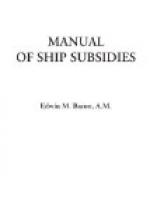Chile grants mail subsidies, which have no appreciable effect in the merchant marine.[FR]
FOOTNOTES:
[Footnote FO: Con. Gen. George E. Anderson, Rio de Janeiro, in Daily Con. Repts., no. 55, p. 719, Sept. 7, 1910.]
[Footnote FP: Daily Con. Repts., March 18, 1911.]
[Footnote FQ: Same, January 20, 1911.]
[Footnote FR: Meeker.]
CHAPTER XIII
THE UNITED STATES
While a navigation code founded in 1790 and 1792, and developed in 1816, 1817, and 1820, after the model of the then existing English code,[FS] has been retained in modified form through enactments in subsequent years, a system of general ship-subsidies, though repeatedly proposed, has never been adopted by the United States. From 1793 to 1866 bounties were given to fishing vessels and men employed in the bank and other deep-sea fisheries,[FT] but no subsidies to the merchant marine were granted till 1845, and these were only postal subsidies—payments in excess of an equivalent for services to be rendered in ocean mail-carriage. The law enacted that year had for its declared purpose the encouragement of American ocean steamship-building and running. With this act, therefore, the real history of Government aid to domestic shipping in this country begins.
At the time of the adoption of this policy America was still leading the world in ocean sailing-ships with her splendid fleets of fast-sailing packets and “clippers”, while England had taken the lead in steamships. The law of 1845 was the culmination of a move begun in Congress in 1841, the year after the first Cunarder had crossed from Liverpool to Halifax and Boston. Its aim was to parry England’s bold stroke for maritime supremacy with her State-aided steamship lines, and directly to “protect our merchant shipping from this new and strange menace."[FU] The first move of 1841 was for an appropriation of a million dollars annually for foreign-mails carriage in American-owned ships.[FU]
The law of 1845 (March 3) authorized the postmaster-general to contract with American ship-owners exclusively for this service to be performed in American vessels, steamships preferred, and by American citizens, for a period of from four to ten years, with the proviso that Congress by joint resolve might at any time terminate a contract. The subsidy was embodied in the rates of postage thus fixed: upon all letters and packets not exceeding a half-ounce in weight, between any ports of the United States and any foreign ports not less than three thousand miles distant, twenty-four cents, with the inland postage added; upon letters and packets over one half-ounce in weight, and not exceeding one ounce, forty-eight cents, and for every additional half-ounce or fraction of an ounce, fifteen cents; to any of the West India Islands, or islands in the




